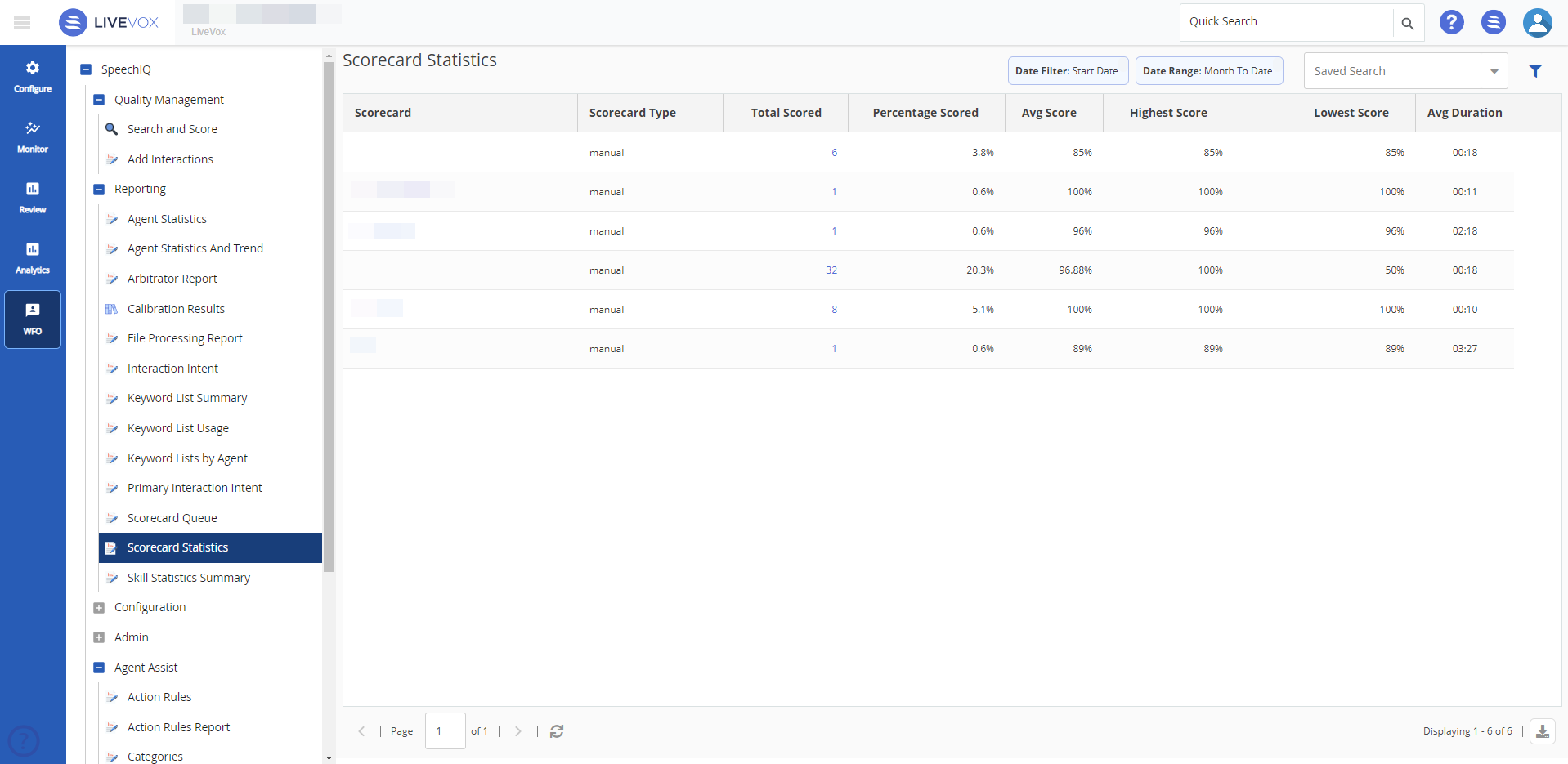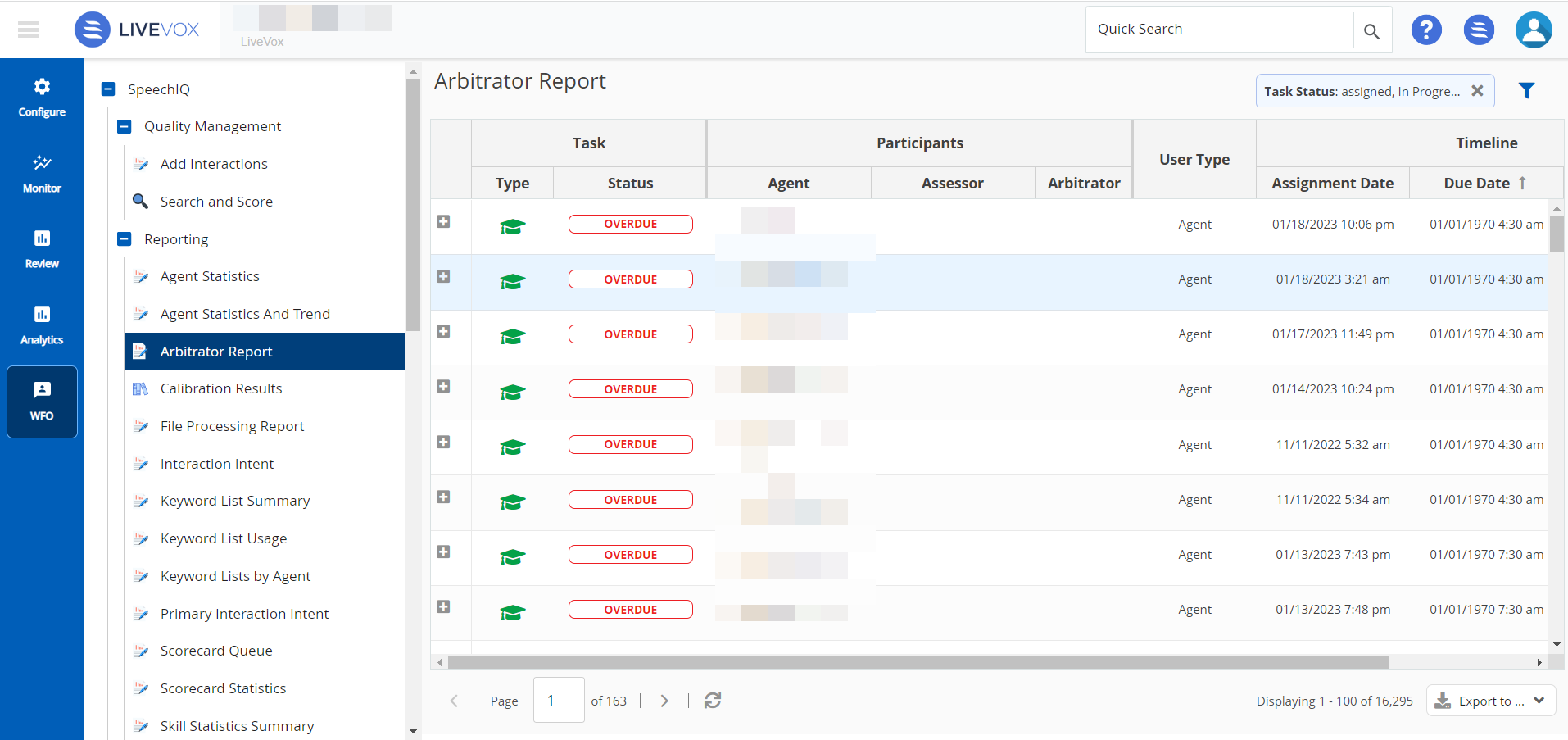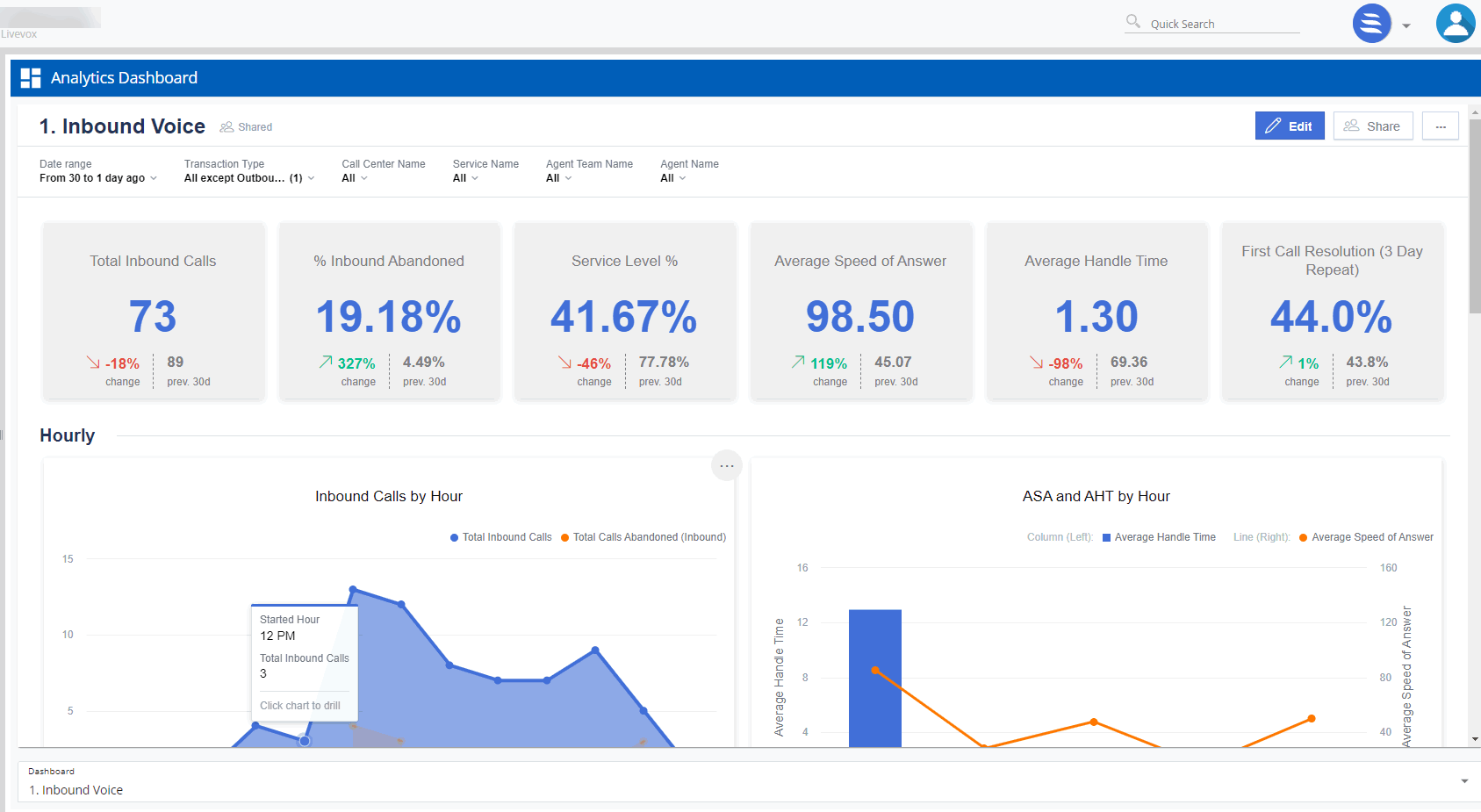Download PDF
Download page WFO.
WFO
Work Center
Work Center provides a unified workspace for agents and supervisors and acts as an up-to-date and centralized hub for all tasks and responsibilities. Work Center provides a consolidated view of all items that need attention, such as work queue tasks, posts, alerts, and notifications. You can use Work Center to compose and receive internal announcements, alerts, and notifications for tasks under the work queue.
The information displayed in Work Center is personalized based on each individual’s access and permissions.
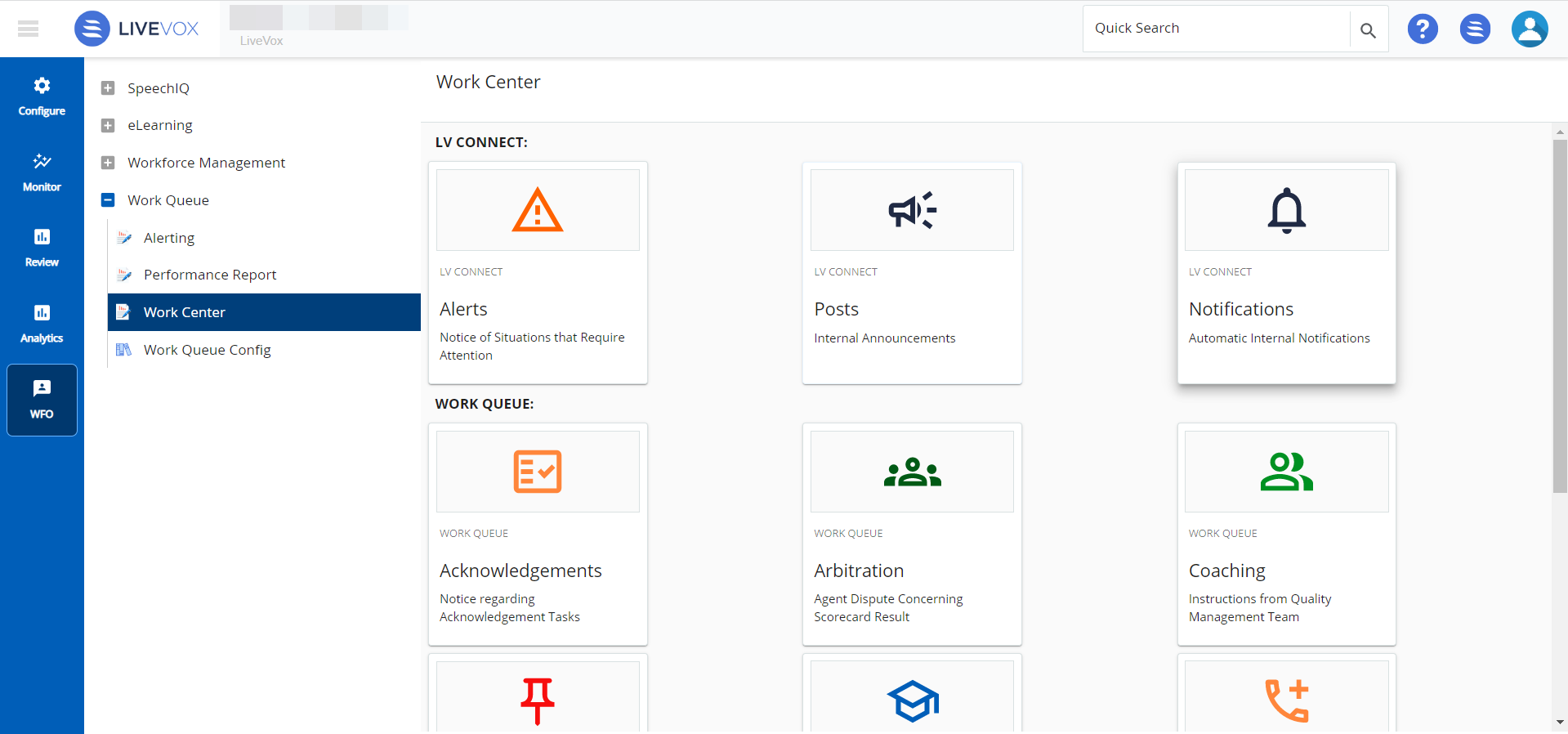
For more information, see Work Center.
Enhanced Keyword Search
The keyword search capability of WFO has been significantly enhanced. You can choose to search for keywords based on Phrase Order (Exact Phrase or Fuzzy Phrase) or Word Match (Exact Word or Fuzzy Word). You can also specify the number of seconds or % duration (in increments of 10) of the call in which you want to search for the keyword.
This feature is available to all users starting with LiveVox U15.
Positional Word Searching
The Scorecards feature of SpeechIQ now supports position-level keyword searches. You can select a word in the interaction as a reference, also called a Pivot Word. The search engine looks for occurrences of keywords before and after the Pivot Word.
This feature is available to all users starting with LiveVox U17.
Interaction Intent Dashboard
The new Interaction Intent Dashboard represents the Interaction Intent Report in the form of customizable charts. You can chart interactions based on intent, reason, and type. The dashboard provides multiple types of charts and you can customize each chart to represent the interactions as needed.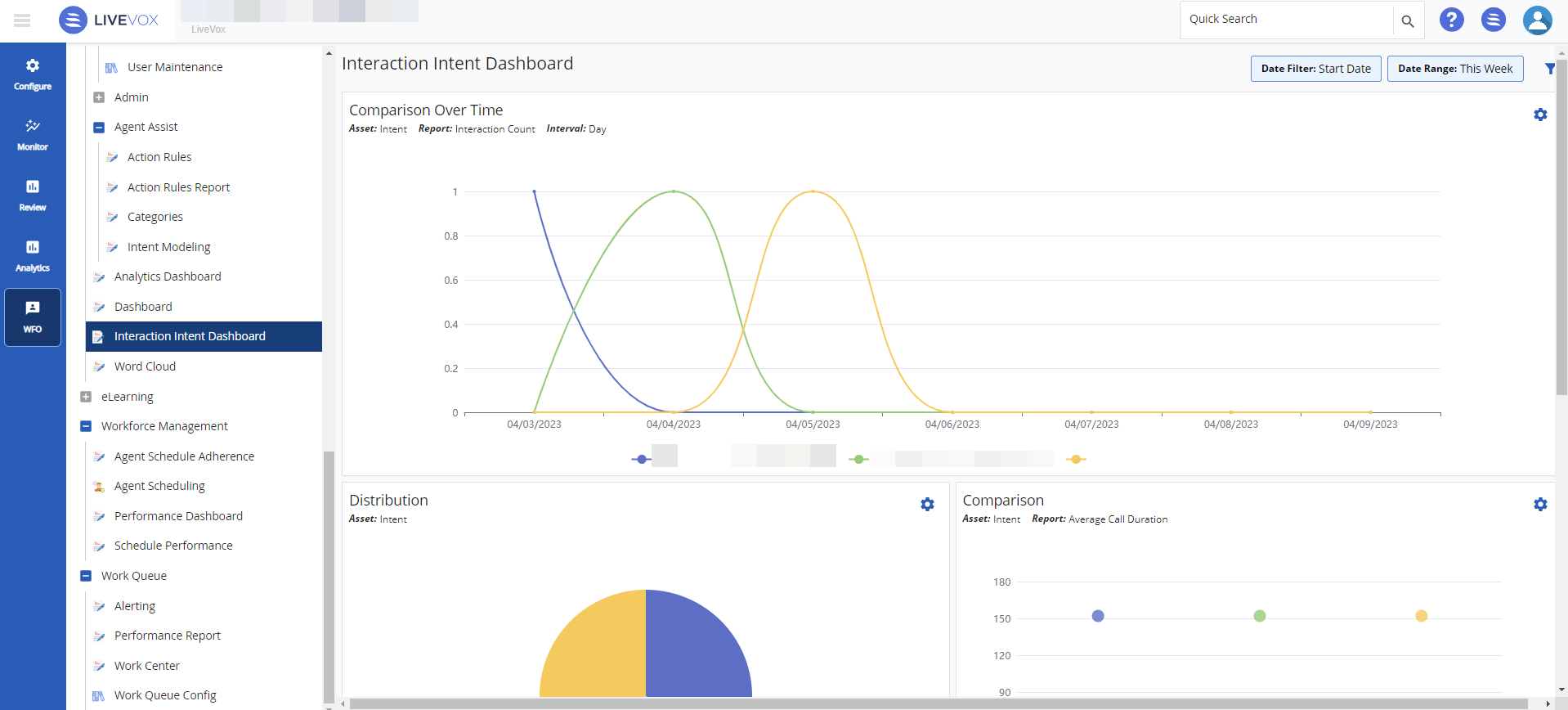
For more information, see Interaction Intent Dashboard.
Enhancements to the Search and Score Screen
Downloadable Call Recordings
You can download the call recording from the LiveVox Portal (LVP). The download option is available on the Interaction Review screen of an interaction.
This feature is available to all users starting with LiveVox U15.
Underlining Keywords in a Transcript
For an interaction (both voice and non-voice), LVP underlines the keywords in the transcript for that interaction on the Interaction Review screen.
Displaying Keyword Bubbles
When a voice interaction is played on the Interaction Review screen, the keywords are highlighted using an information bubble. This enables you to find the keywords found in the interaction and know when they are found.

Playing Audio from the Search and Score Screen
You can play audio interactions directly from the Search and Score screen without opening them in another window. This feature helps when you are searching for a specific interaction.
Downloading Transcripts
You can download the transcripts for all types of interactions (email, SMS, and voice) from the Interaction Review screen. Transcripts can be downloaded in two different ways:
- A single transcript can be downloaded in PDF format.
- Multiple transcripts can be selected for download. The transcripts are downloaded in .csv format. If a keyword is part of the filter criteria for the list of interactions, the keywords are downloaded as well.
Searching for Interactions
You can search for interactions based on the Interaction Disposition field on the Search and Score screen. The Interaction Disposition field has been added to the Advanced Search option.
This feature is available to all users starting with LiveVox U15.
Transcribing Voice with Customer Sentiment
You can transcribe calls and view the sentiment analysis for an interaction using the Interaction Review screen within the Search and Score page and on the agent desktop. Sentiment analysis is done on segments of the interactions (first 25%, second 25%, and so on). Both positive and negative sentiments are captured for your review.

Interaction Search Randomizer
The Search and Score screen allows you to search for a random sample of calls for monitoring/scoring based on a set of filter criteria. This feature enables users to make truly random selections for scoring purposes without bias or prejudice.
Instant Trend Analysis with Comparison Chart
The Search and Score feature of SpeechIQ allows you to chart the filtered data onto a graph. On the Search and Score screen, when you search using a combination of filters, a list of interactions that match the filter criteria is displayed. The Comparison Chart option summarizes the results into a chart format that can help you analyze the results. You can also save the chart and use it for shared analysis in your contact center.
This feature is available to all users starting with LiveVox U17.
Add Interactions Manually
The Add Interactions window under SpeechIQ > Quality Management lets you manually add nonvoice interactions to SpeechIQ. The interactions that are added manually can be evaluated and processed like the other interactions. You can add Chat, Email, and SMS interactions using this feature.

For more information, see Adding Interactions.
Scorecard Statistics Report
The Scorecard Statistics Report in the Reports section summarizes the results of scored interactions. You can analyze the performance results in the report at the question and agent levels.
This feature is available to all users starting with LiveVox U17.
For more information, see Scorecard Statistics.
Scorecard Results Export
The PDF format of the exported or downloaded Scorecard Results Report has been updated to include the Account Number.
Agent Statistics and Trend Report
A new report, called the Agent Statistics and Trend Report has been added under the Reports section of SpeechIQ. This report displays performance statistics for your agents based on the scored interactions and captures scoring information including the highest, lowest, and average score for an agent. Information, such as average silence, average agent and customer sentiments, and average talk-over percentage are also included in the report.
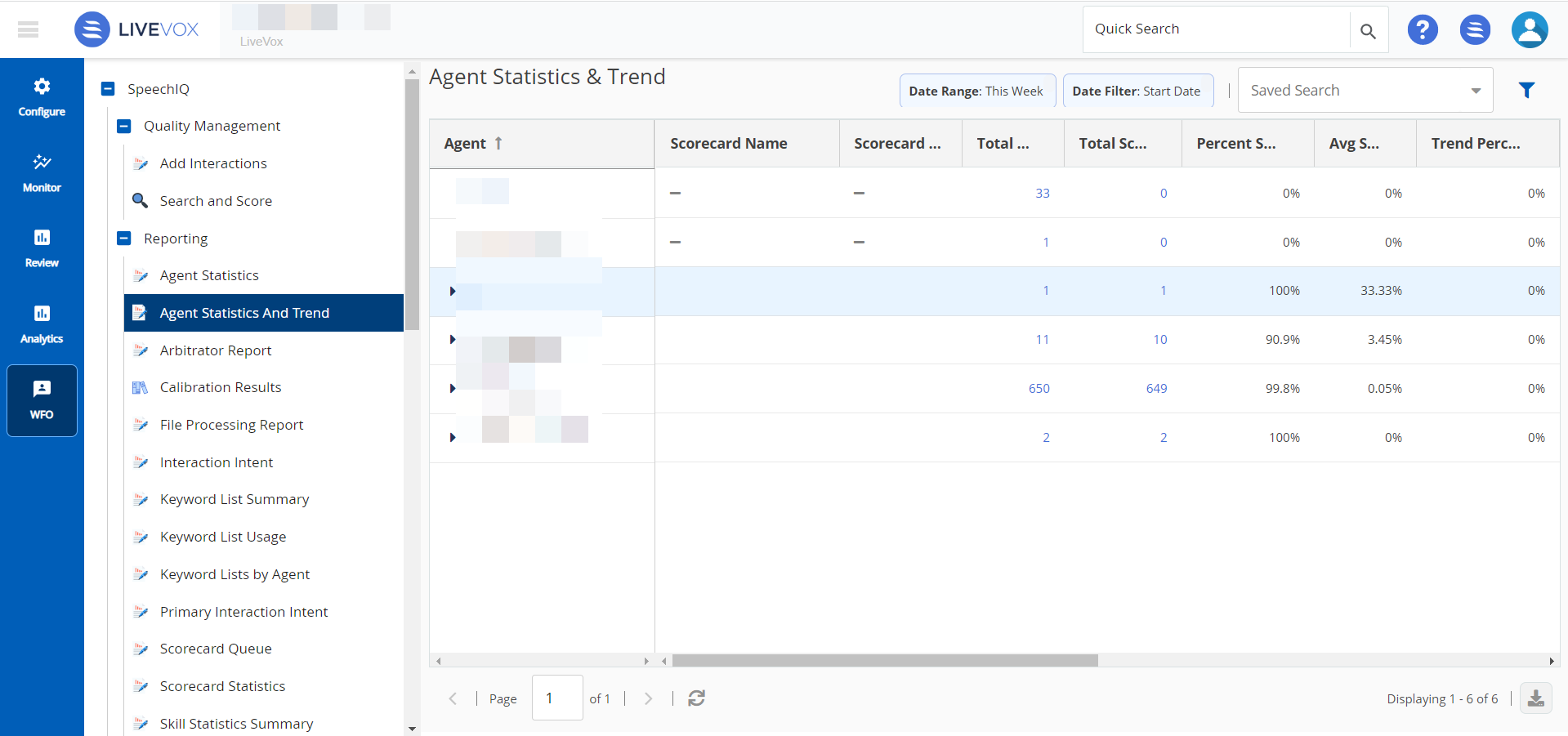
For more information, see Agent Statistics and Trend Report.
Enhancements to Agent Scheduling
Agent Scheduling has been enhanced to include different categories of activities, such as lunch, meeting, training, and so on within a currently scheduled shift.
Performance Dashboard
The Performance Dashboard is a configurable solution that allows you to monitor the performance of your call center, service, team, or agents. The dashboard offers metrics and insights that can be tailored to a specific requirement. This information helps decision-makers analyze critical areas to gauge how effectively a call center, service, team, or agents are working. The Performance Dashboard enables you to:
- Configure tolerance levels for key performance metrics.
- Set automatic trigger alerts to relevant team members to address performance concerns.
- Monitor the performance of teams and analyze the various metrics.
- View agent statistics and quality management scores.
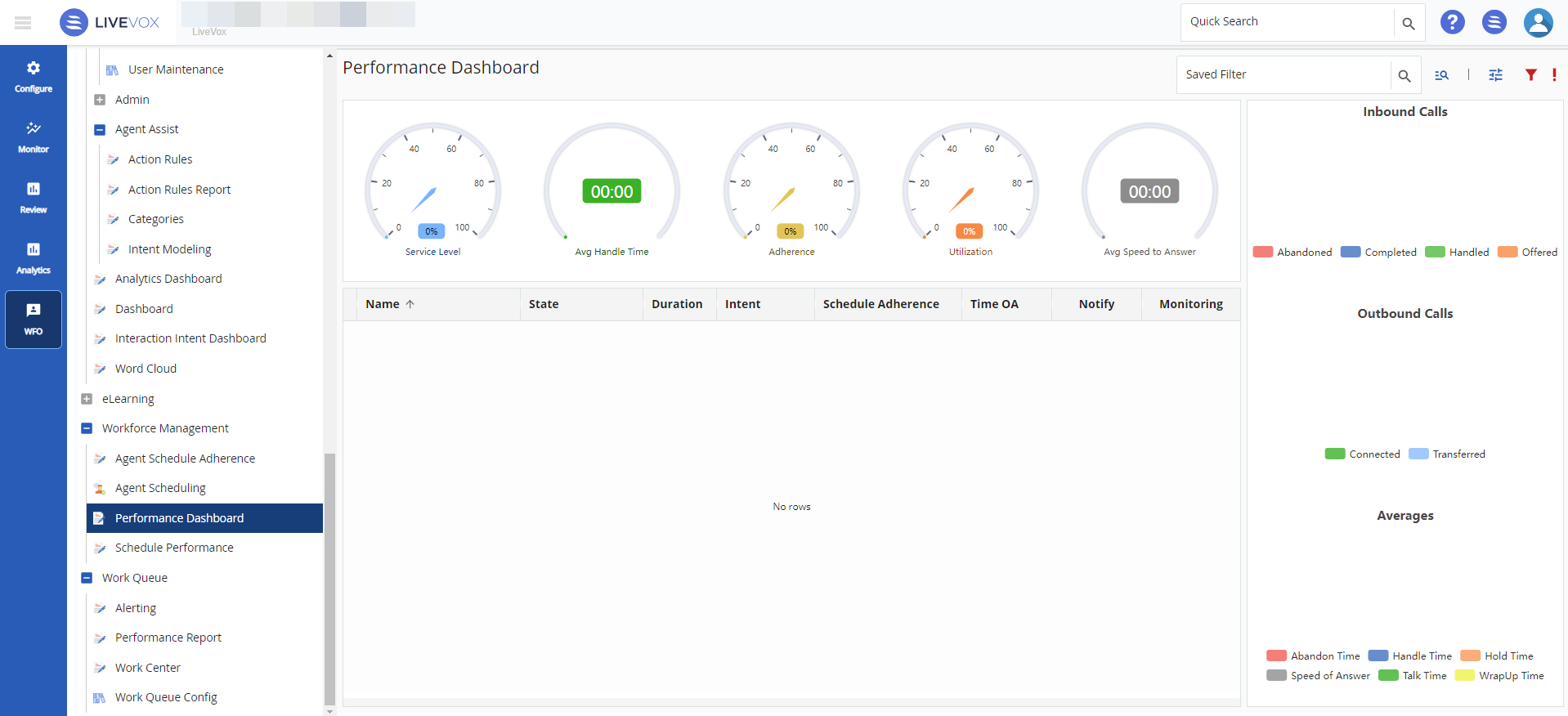
For more information, see Performance Dashboard.
Agent Assist
The Agent Assist feature has been introduced in the LiveVox Portal. Managers can use Agent Assist to guide agents in handling interactions in real-time. Managers can evaluate interactions for content and display relevant information to the agent. These evaluations can range anywhere from compliance adherence to script coaching. Agent Assist can also be configured to notify managers or agents in certain scenarios, such as generating automated reports. You can configure different types of notifications, such as email, SMS, Work Queue, and Compliance Dashboard. Depending on what was said during the call, you can also use Agent Assist to initiate automated tasks on behalf of the agent using API calls.
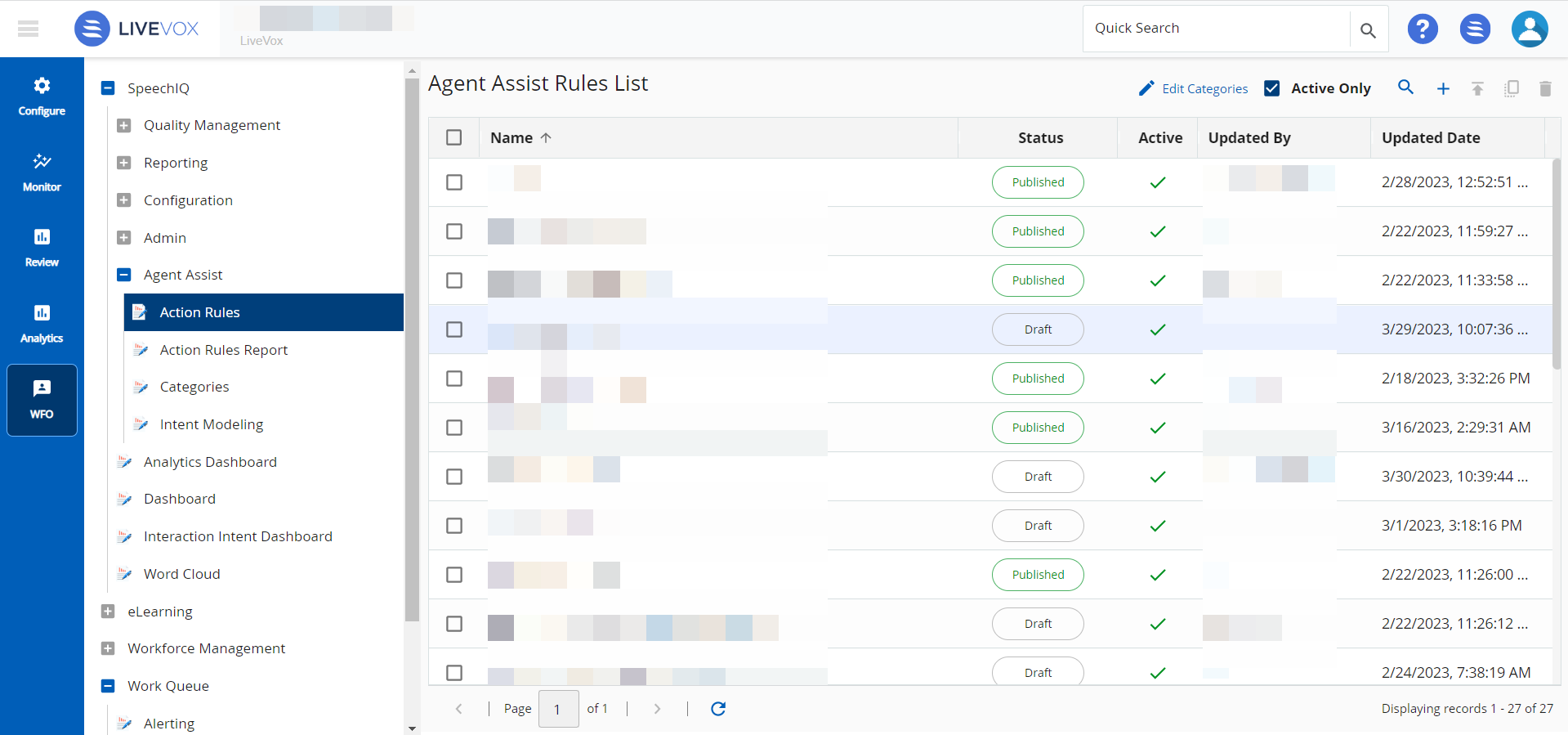
For more information, see Agent Assist.
Real-Time Processing of Calls for Intent Identification
The LiveVox Portal now uses machine learning to identify intents throughout an interaction. The transcripts along with the intents are leveraged by Agent Assist for further use and analysis.
Call Summarization
A summary of calls is available for agents. This feature saves time for an agent and improves the accuracy of the transcription summary. The transcript is also analyzed for conversational insights, to improve calling strategies, and enhance the readability and accuracy of notes.
Keyword Capturing
The LiveVox Portal has now been enhanced to capture a list of keywords using machine learning. Many interactions are transcribed, and a list of keywords is recommended. You can review the recommended keywords and add words to the keyword list.
Keywords Modeling
The Livevox Portal can now transcribe interactions and recommend a list of keywords based on the frequency and significance of the words used. The Keyword Modeling screen under SpeechIQ > Configuration enables you to evaluate the contents of each list for relevance and create custom Keyword Lists for your organization.
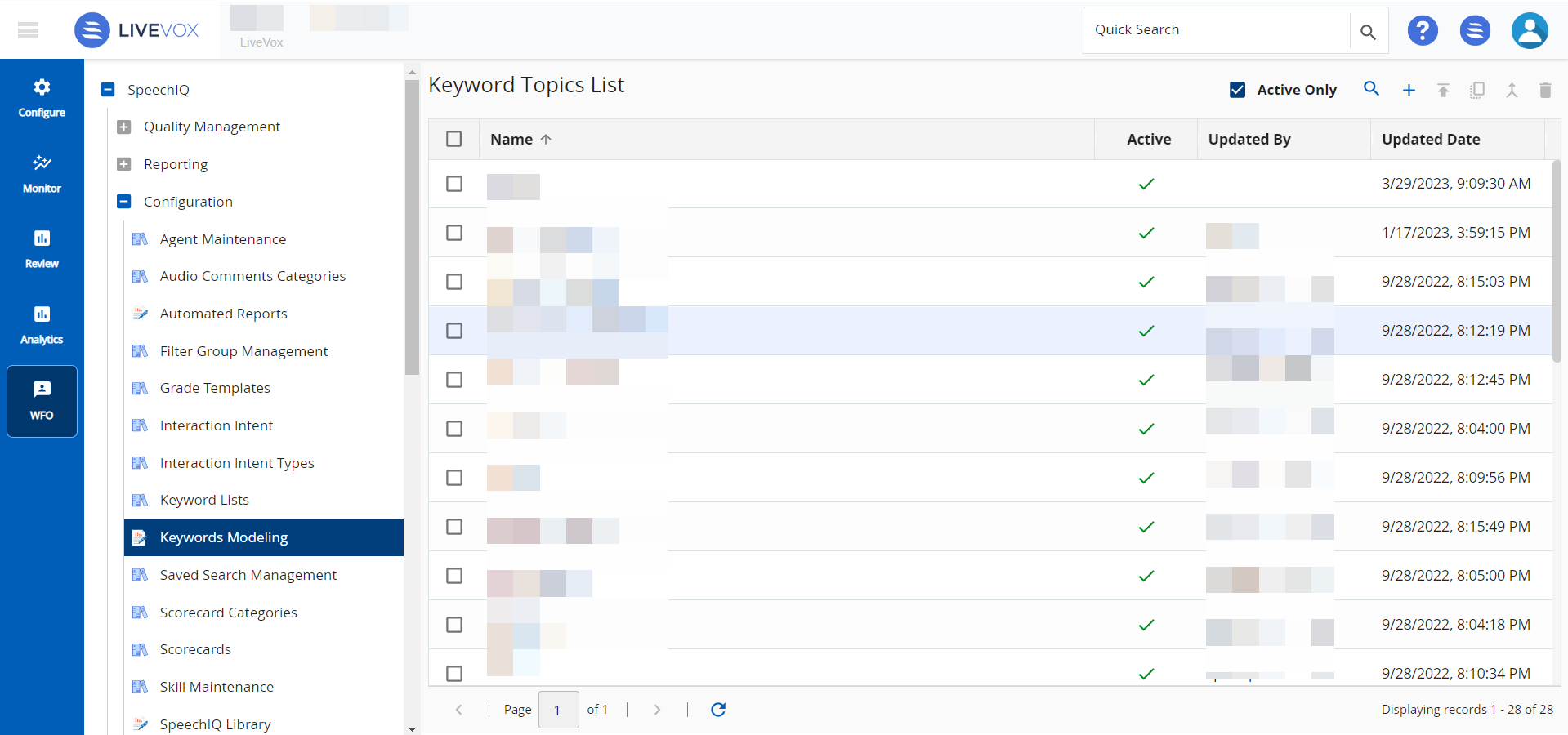
For more information, see Keyword Modeling.
Arbitrator Report
A new report named the Arbitrator Report has been introduced under SpeechIQ > Reporting. The Arbitrator Report contains information about all the arbitration tasks, such as the status of the task, names of the participants for that particular arbitration task (agents, assessors, and arbitrators), and timeline information for the task (assignment, due, and completion dates).
This feature is available to all users starting with LiveVox U17.
For more information, see Arbitrator Report.
SpeechIQ Analytics Dashboard.
For customers who have Business Intelligence (BI) enabled, a new dashboard called Analytics Dashboard has been introduced under SpeechIQ. This dashboard is a collection of widgets that provide data, such as reports and metrics at-a-glance. It provides excellent reporting and intelligence capabilities at your fingertips. Widgets, such as Total Inbound Calls, % Inbound Abandoned, Service Level %, Average Speed of Answer, Average Handle Time, and First Call Revolution are part of this dashboard.
This feature is available to all users starting with LiveVox U17.
For more information, see Analytics Dashboard.
File Processing Report
A new report called the File Processing Report, has been added under SpeechIQ > Reporting. This report enables you to track file uploads.
This feature is available to all users starting with LiveVox U17.
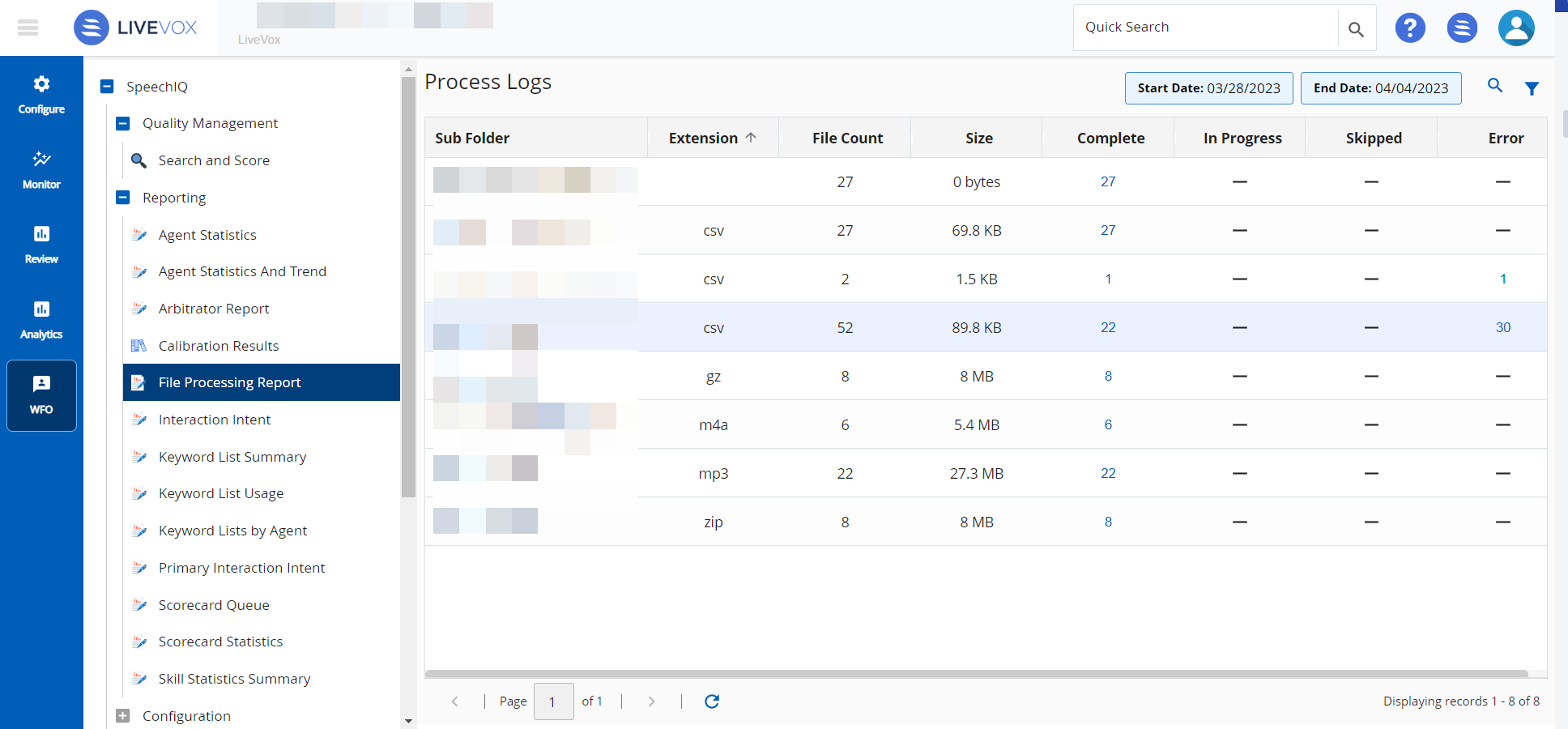
For more information, see File Processing Report.



